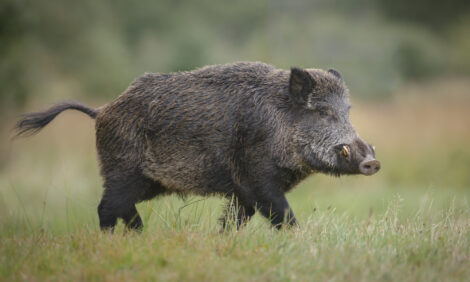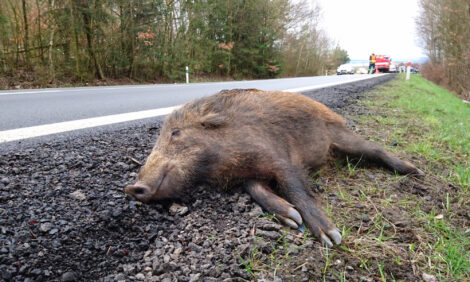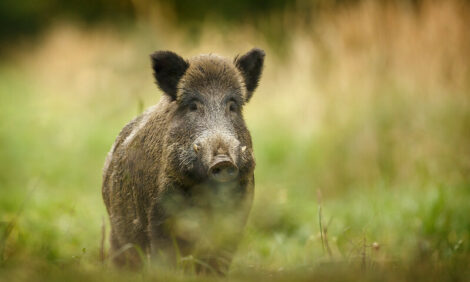



African swine fever in wild boar: carcass disposal options
Learn more about the options for wild boar carcass disposalEditor's note: the following is an excerpt from African swine fever in wild boar populations - ecology and biosecurity. It was created by the FAO, WOAH and European Commission. Additional content from the booklet will be shared as an article series.
Due to the epidemiological evolution of ASF in Eurasia, each wild boar carcass, even if detected hundreds of kilometres away from the nearest infected area, should be considered as a suspected ASF case unless the presence of the virus is ruled out through laboratory testing. All precautionary measures aimed at limiting the possible further spread of the virus should be taken at the site where carcasses are found and while waiting for laboratory test results. Following ASFV detection, all biosecurity measures should be promptly implemented for each detected carcass. The main aim of carcass disposal is to reduce the probability of the virus remaining locally.
The movement of carcasses within the infected area, from the spot they are found to a designated carcass collection point, must be carried out to prevent further spread of the virus. The burial or burning area should be located taking into account the availability of facilities to disinfect vehicles, personnel and equipment. Vehicles (particularly the underside or the bed, if carcasses are transported in the cab) and personnel (shoes, equipment) should be cleaned and disinfected before leaving the infected area.
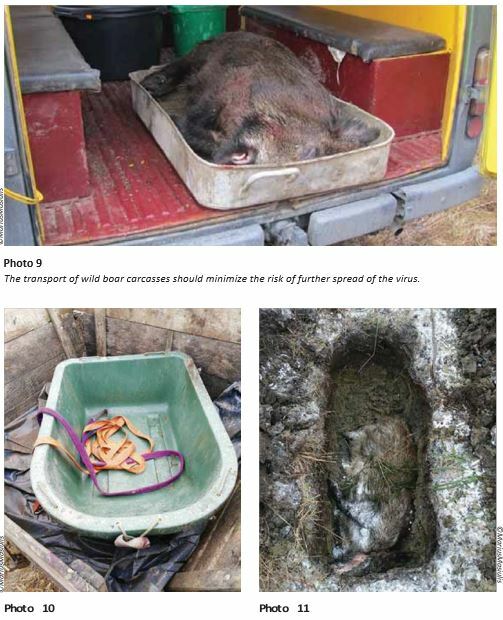
Carcasses should be placed in durable plastic bags and then transported into plastic or metal tanks suitable for repeated disinfections. The tanks enable the carcasses to be moved through the forest more easily. Stones, snow or vegetation cannot damage the plastic bags and infected fluids cannot leak out. Vehicles must be disinfected before leaving the infected area. Containers must be regularly cleaned and disinfected before they can be reused.
The carcass and the spot it was found should be disinfected to minimize the ASF viral load. These procedures are easy to implement in all seasons with the exception of winter when carcasses are frozen, are often covered with snow and temperatures are below 0 °C and the disinfectant freezes. In such situations, anti-freezing agent is added to the disinfectant to stop it from freezing. Propylene glycol can be used as a diluent.
Each country has approved and/or authorized a list of biocides that are effective against ASFV; only these authorized biocides should be used and in accordance with the producer’s instructions.
Carcass disposal: incineration or rending and on-the-spot burial or burning
Incineration or rendering is the most effective and easiest way to dispose of carcasses. Rendering is a process that converts waste animal tissue into stable, usable materials. It is a closed system for the mechanical and thermal treatment of animal tissues that results in stable, sterilized products, such as animal fat and dried animal protein, by grinding tissue and sterilizing it by heat under pressure.
Although rendering is the most economical method to dispose of carcasses, the movement of infected carcasses to the rendering plant carries some risk of the disease spreading, so precautions must be taken. Not all countries have rendering plants, and existing rendering plants may not always accept wild animal carcasses. For this reason, agreements with rendering plants should be sought beforehand or other alternative methods of carcass disposal should be used. Carcasses can be sampled directly in the rendering plant, which minimizes the risk of local viral contamination. Incineration is a treatment process that involves the combustion of organic substances contained in waste materials (or carcasses in this case). During the incineration process, carcasses are converted into ash, flue gas and heat.
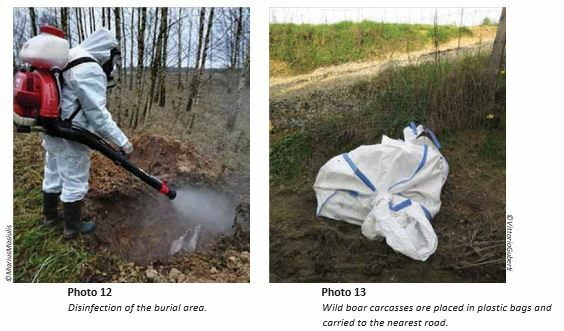
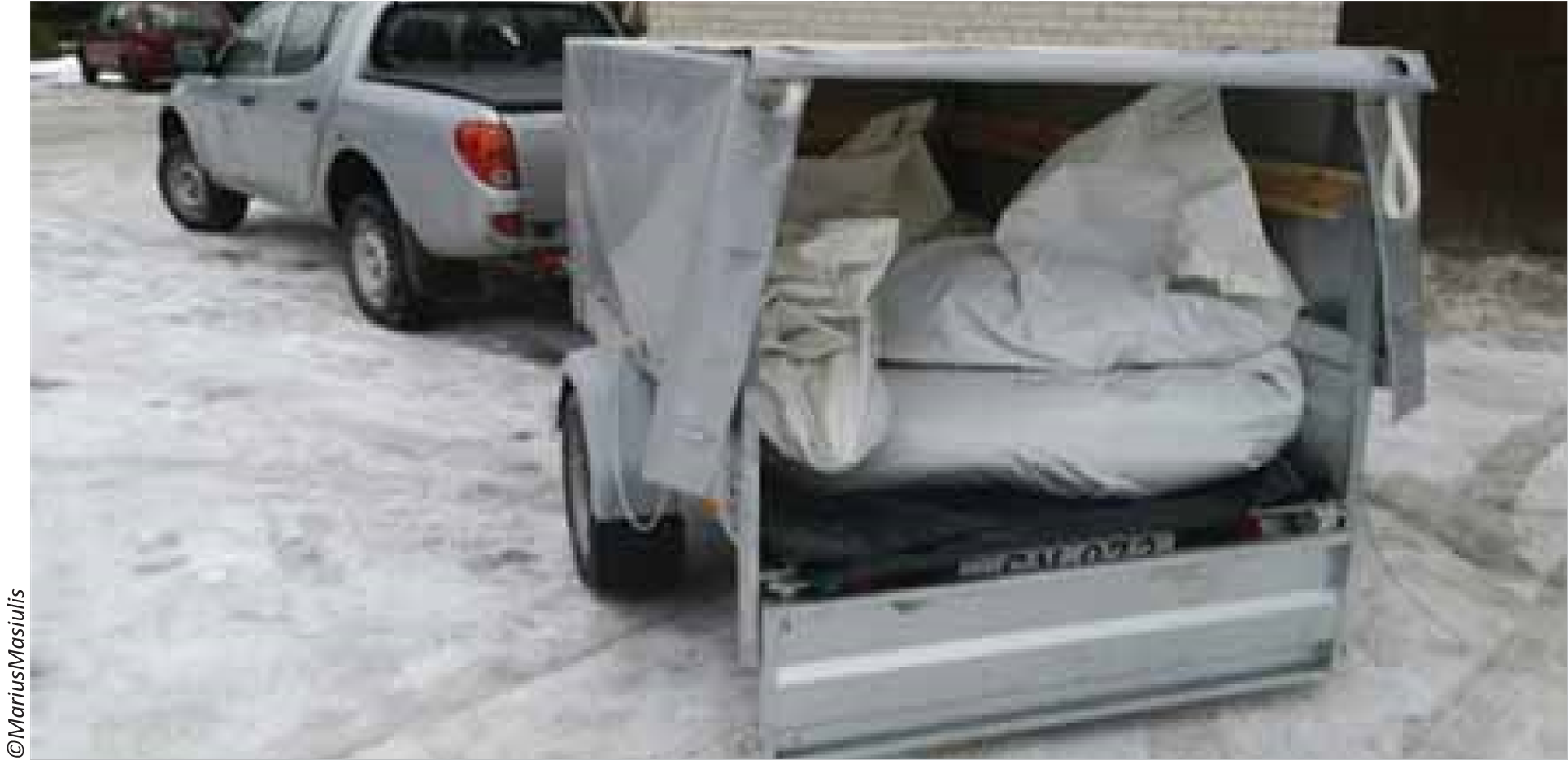
Containers
Carcasses can be managed by using containers. Special containers (with a 400–600 litre capacity) should be strategically distributed nearby the nearest paved roads. Carcasses can then be placed in the containers directly by hunters using appropriate vehicles and following biosecurity procedures. Hunters should inform the local veterinary service, which then plans the disposal of the carcasses. Usually, the company that manages the rendering plant or incinerator directly collects the carcasses, with the veterinary service supervising the process. The containers must be robust, lockable and leak-proof. The use of containers is relatively easy and quick to implement. When strategically placed, containers help prevent the spread of ASFV outside the infected area.
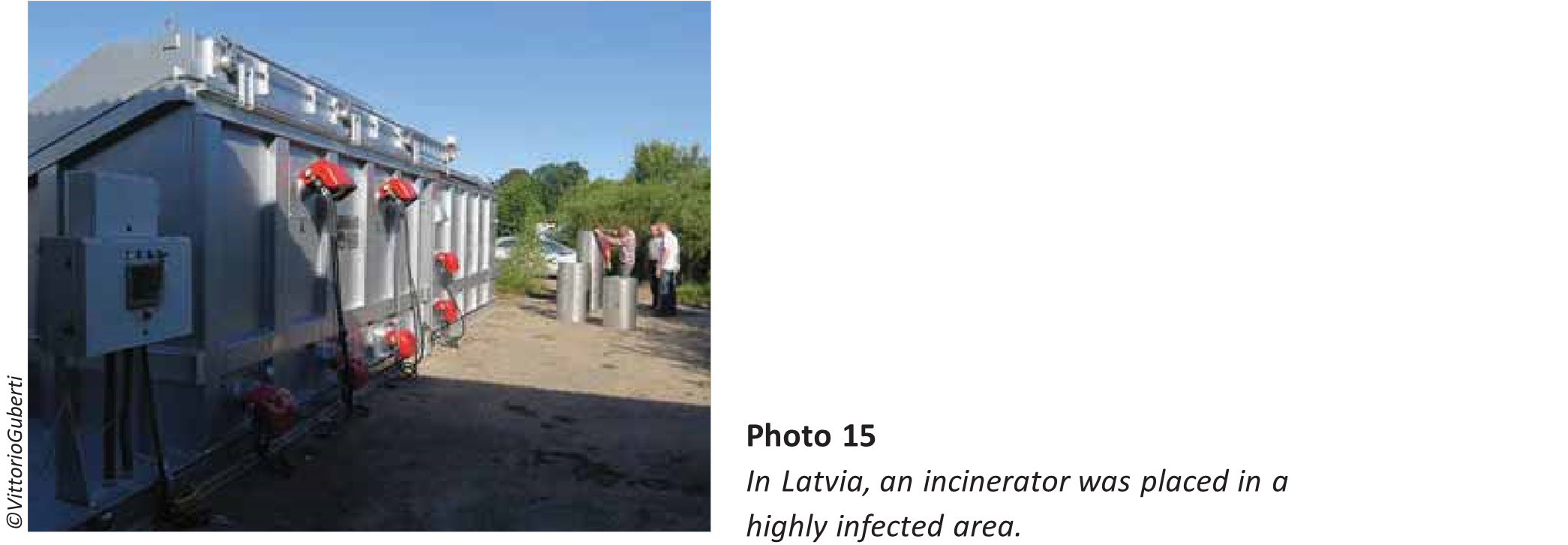

On-the-spot burning
Any burning must minimize environmental pollution and comply with fire safety regulations. The practice may be banned in many countries. Burning carcasses in an outdoor area using combustible materials as a primary fuel source can be carried out in several ways: pyre burning; pit burning; above-ground incineration (fireboxes or a mobile incineration device); or a combination of these methods.
When constructing a pyre or digging a pit for burning carcasses, it is important to maximize the airflow. Primary fuel sources must be combustible materials such as dry wood or coal briquettes that have a low or negligible environmental impact. Plastics, tyres and other potentially toxic inflammable materials can be used with the approval of the competent authorities (usually the ministry of the environment). Straw or hay should be used only to start the fire, due to the smoke these materials produce. Liquid fuels are often needed to initiate the burning.
Trained personnel must be involved in the process and the burning area must be carefully selected and cleared. Activities should only be carried out when firefighting tools and related facilities are available. On-the-spot carcass burning is a slow process, as it requires time to select and clear the area, transport large quantities of hardwood, complete the burning of the carcass and prevent the fire from spreading.
The complete burning of a wild boar carcass can take up to 68 hours. After the carcass has been burned, ashes should be buried and the potentially contaminated surroundings disinfected.

Burial
On-the-spot burial is another carcass disposal method. The procedure should be agreed with the environmental service and clear instructions on how to bury the carcass should be made available.
Single pit
This method is used when individual dead wild boar are found. Burial pits should be deep enough to ensure that a soil layer of at least 1 m can be placed on top of the carcass to prevent scavenging. The bottom of the pit should be at least 1 m above the seasonal maximum groundwater level to avoid contamination. The availability of groundwater maps and instructions will help minimize such risks. Carcass decomposition is faster when plastic bags are removed as these take years to decompose. The minimum distance between the pit and watercourses, lakes or ponds should be indicated by the environmental protection service.
Carcasses should be disinfected once in the pit and covered by pressed soil.
On-site trench burial
This method is generally used when several carcasses are found in the same area or when weather conditions prevent the digging of several single pits (e.g. in the winter, when the ground is frozen). An excavator usually digs the trench and carcasses are placed on the bottom and covered with soil. The high number of carcasses requires a formal environmental authorization. To avoid the reuse of trenches, their location must be registered using geographical coordinates. There is no limit to the number of carcasses that can be disposed of in a single trench, but it must be dug to the required size and depth (1.8–2 times the entire volume of the carcasses to be disposed of with at least 1 m of soil cover and at the prescribed distance from groundwater). Before covering the trench with soil, carcasses must be disinfected. Plastic bags are not recommended because of their lengthy decomposition rates.

Mass burial
This method applies the same rules set for domestic pigs in commercial farms. Mass burial is appropriate when the local geological characteristics prevent leakage and when transportation to the incinerator or rendering plant is not possible. The burial area and the carcasses must be disinfected with appropriate disinfectants. The abdomen of fresh carcasses must be opened to limit the side effects of gas production during putrefaction.
INDIRECT CONTAMINATION OF THE HABITAT WITH AFRICAN SWINE FEVER
In any ASF-infected environment, the virus could be present in several matrices. Infected material, such as faeces, blood, grass and mushrooms, is likely to be mechanically transported outside the infected area, thus representing an indirect risk for further spread of the virus. Mushroom or forest berry collectors, as well as forest workers and hunters, are the most at risk of indirectly spreading the virus.
Previous data on the infectivity of faeces have been recently reconsidered (EFSA, 2010a; Davies, 2017; Olesen, 2018). The most recent research demonstrates that only 10 percent of the faeces from an infected wild boar contain the virus, with its survival relatively short at room temperature (higher than 18 °C). According to these data, the probability of stepping on infected faeces and carrying the virus outside infected areas during summer or early autumn months is negligible.
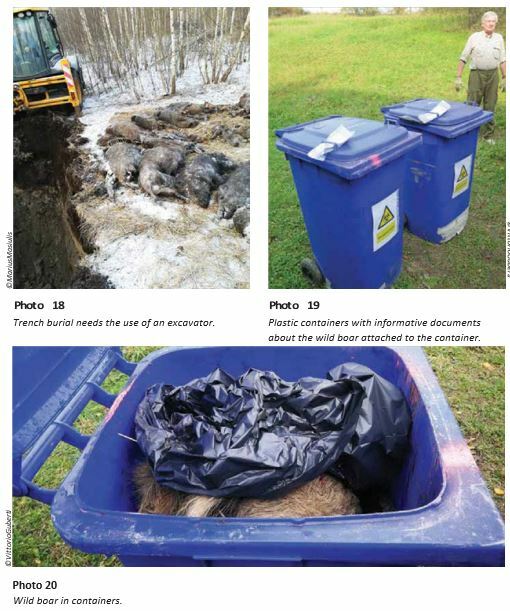
However, during winter months, the risk in northern and eastern European countries could be higher, as low temperatures allow longer survival of the virus (weeks or months instead of a few days) and more virus-contaminated faeces may accumulate in colder periods of the year. In winter months, wild boar are also more likely to cluster around feeding and baiting points, meaning their daily home ranges are reduced, resulting in a higher probability that the environment will be locally contaminated with infected faeces. Around 50 percent of wild boar faeces are located in a small area (up to 0.4 hectares) surrounding feeding points (Plhal et al., 2014). Hunters often visit feeding or baiting points to refill or check them or to set up cameras to estimate the size of the wild boar population. In such circumstances, the probability of stepping on infected material and transporting the virus outside the infected area is increased and should be avoided and managed.
Non-hunters (visitors or workers of the infected forest or area) should be informed about the possibility of being contaminated by the virus when exploiting resources in the infected forest or area, whereas domestic pig owners exploiting resources the area should be informed about the risk of the mechanical transmission of the virus as part of pig biosecurity. Information should be provided on posters or signs at the entrance to the infected area, with bullet points on how to mitigate the risk of ASF.
An easy and likely already largely applied measure is the use of different clothes and boots while visiting an infected or at-risk area that should be changed before leaving the area. Boots should be placed in a robust plastic bag to avoid any contamination of cars while driving home and then brushed and washed with soap and hot water until the soles are clean.
Hunters should be aware that several activities carried out in the infected area risk the mechanical transportation of the ASFV outside the habitat. Some precautionary measures should be applied, such as avoiding the use of a private car for the transportation of feeding items directly to the spot, and carefully disinfecting boots and any possibly contaminated materials on return to the hunting lodge or dressing facilities.
KEY MESSAGES
- Countries at risk should develop a clear strategy for finding (passive surveillance) and disposing of carcasses before the introduction of the virus.
- Competent authorities must facilitate the reporting of carcasses, raise awareness and organize effective communication channels.
- In infected areas, rendering is an easy and effective method to dispose of carcasses. Containers can help in the temporary storage of carcasses, which are to be sampled at the rendering plant by an official or authorized veterinarian.
- Other carcass disposal methods include incineration, burning and burial.
- The human exploitation of forest resources poses a risk for the mechanical transportation of the virus outside the infected forest. Very simple and basic biosecurity measures can minimize this risk.
Guberti, V., Khomenko, S., Masiulis, M. & Kerba S. 2022. Chapter 4. African swine fever in wild boar – Ecology and biosecurity. Second edition. FAO Animal Production and Health Manual No. 28. Rome, FAO, World Organisation for Animal Health and European Commission. https://doi.org/10.4060/cc0785










